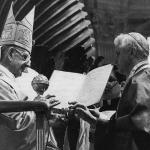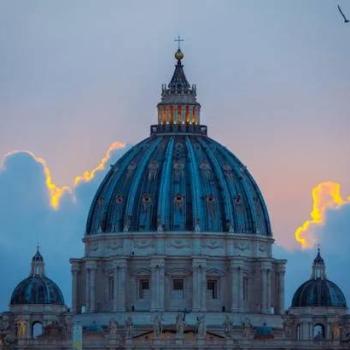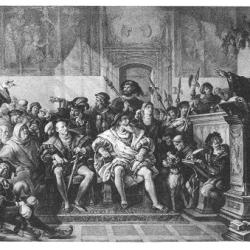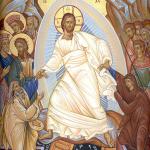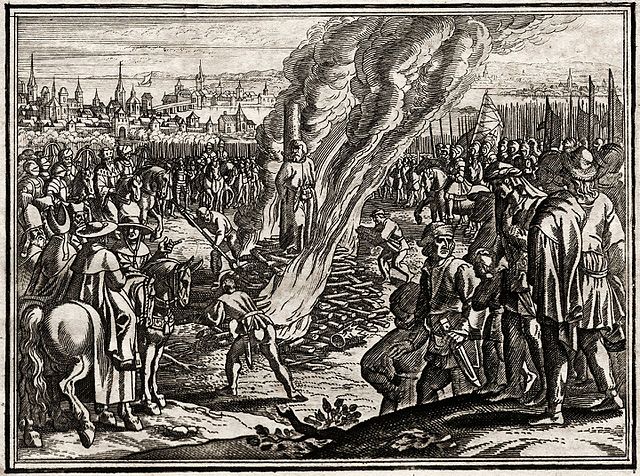
[see the Master List of all twelve installments]
Paolo Pasqualucci (signer of three of the endless reactionary-dominated “corrections” of Pope Francis), a Catholic and retired professor of philosophy of the law at the University of Perugia, Italy, wrote “‘Points of Rupture’ of the Second Vatican Council with the Tradition of the Church – A Synopsis” (4-13-18), hosted by the infamous reactionary site, One Peter Five. It’s an adaptation of the introduction to his book Unam Sanctam – A Study on Doctrinal Deviations in the Catholic Church of the 21st Century.
Pope Benedict XVI, writing as Cardinal Ratzinger, stated that the authority of Vatican II was identical to that of the Council of Trent:
It must be stated that Vatican II is upheld by the same authority as Vatican I and the Council of Trent, namely, the Pope and the College of Bishops in communion with him, and that also with regard to its contents, Vatican II is in the strictest continuity with both previous councils and incorporates their texts word for word in decisive points . . .
Whoever accepts Vatican II, as it has clearly expressed and understood itself, at the same time accepts the whole binding tradition of the Catholic Church, particularly also the two previous councils . . . It is likewise impossible to decide in favor of Trent and Vatican I but against Vatican II. Whoever denies Vatican II denies the authority that upholds the other two councils and thereby detaches them from their foundation. And this applies to the so-called ‘traditionalism,’ also in its extreme forms. Every partisan choice destroys the whole (the very history of the Church) which can exist only as an indivisible unity.
To defend the true tradition of the Church today means to defend the Council. It is our fault if we have at times provided a pretext (to the ‘right’ and ‘left’ alike) to view Vatican II as a ‘break’ and an abandonment of the tradition. There is, instead, a continuity that allows neither a return to the past nor a flight forward, neither anachronistic longings nor unjustified impatience. We must remain faithful to the today of the Church, not the yesterday or tomorrow. And this today of the Church is the documents of Vatican II, without reservations that amputate them and without arbitrariness that distorts them . . .
I see no future for a position that, out of principle, stubbornly renounces Vatican II. In fact in itself it is an illogical position. The point of departure for this tendency is, in fact, the strictest fidelity to the teaching particularly of Pius IX and Pius X and, still more fundamentally, of Vatican I and its definition of papal primacy. But why only popes up to Pius XII and not beyond? Is perhaps obedience to the Holy See divisible according to years or according to the nearness of a teaching to one’s own already-established convictions? (The Ratzinger Report, San Francisco: Ignatius, 1985, 28-29, 31)
For further basic information about the sublime authority of ecumenical councils and Vatican II in particular, see:
Conciliar Infallibility: Summary from Church Documents [6-5-98]
The Bible on Papal & Church Infallibility [5-16-06]
Authority and Infallibility of Councils (vs. Calvin #26) [8-25-09]
The Analogy of an Infallible Bible to an Infallible Church [11-6-05; rev. 7-25-15; published at National Catholic Register: 6-16-17]
“Reply to Calvin” #2: Infallible Church Authority [3-3-17]
“On Adhesion to the Second Vatican Council” (Msgr. Fernando Ocariz Braña, the current Prelate of Opus Dei, L’Osservatore Romano, 12-2-11; reprinted at Catholic Culture) [includes discussion of VCII supposedly being “only” a “pastoral council”]
Pope Benedict on “the hermeneutic of reform, of renewal within continuity” (12-22-05)
The words of Paolo Pasqualucci, from his article, noted above, will be in blue:
*****
11. In the Decree On Religious Liberty Dignitatis Humanae (DH), a concept of “religious liberty” is affirmed which does not seem to distinguish itself from the secular concept of the same, which is the fruit of the idea of tolerance, the origins of which are in Deism and the Enlightenment. Such a concept appears not to conform to the doctrine of the Church and is a harbinger of indifferentism and agnosticism.
My friend and fellow Catholic apologist Tim Staples thoroughly disposes of this in an excellent article, “Religious Liberty” (Catholic Answers, 1-9-15):
Our Lord himself removed all doubt concerning man’s freedom when he revealed that as God from all eternity he willed to gather “Jerusalem” as his own, but they refused him:
Jerusalem, Jerusalem, killing the prophets and stoning those who are sent to you! How often I would have gathered your children together as a hen gathers her brood under her wings, and you would not (Matt. 23:37)! . . .
The claim is made that . . . the Council contradict[s] earlier Magisterial teachings of the Church that condemn “religious freedom,” and so, must be considered heretical.
And one can certainly see how a surface reading of Magisterial statements . . . could be so construed . . . Pope Leo XIII, in his Encyclical Letter, Libertas, 42, June 20, 1888, is also used to this end:
From what has been said it follows that it is quite unlawful to demand, to defend, or to grant unconditional freedom of thought, of speech, or writing, or of worship, as if these were so many rights given by nature to man. For, if nature had really granted them, it would be lawful to refuse obedience to God, and there would be no restraint on human liberty. It likewise follows that freedom in these things may be tolerated wherever there is just cause, but only with such moderation as will prevent its degenerating into license and excess. And, where such liberties are in use, men should employ them in doing good, and should estimate them as the Church does; for liberty is to be regarded as legitimate in so far only as it affords greater facility for doing good, but no farther.
Two points in Response
1. These declarations of the Holy See [Dave: he had also cited Pope Gregory XVI’s Encyclical Letter, Mirari Vos, from 1832] condemn an absolute religious freedom that casts off all constraints of Natural Law and Church authority. This is essentially different from what DH is speaking about. Notice, DH 2 includes key phrases like, ”within due limits,” and “provided that just public order be observed,” to emphasize limitations on religious liberty. There is not even a hint of its approval of what Pope Gregory XVI called “indifferentism,” or what Pope Leo XIII called “unconditional freedom…”
2. The Council Fathers were careful to define what the Church means by “religious freedom” in the context of DH.
This Vatican Council declares that the human person has a right to religious freedom. This freedom means that all men are to be immune from coercion on the part of individuals or of social groups and of any human power…
By “religious freedom,” the Council meant men “are to be immune from coercion.” This is absolutely consonant with Catholic teaching.
And notice as well the Council spoke of the evil of coercion by human power. This in no way means man is not bound by God’s law, or by divine authority. That was not even a consideration here. In other words, Vatican II is not presenting a “right to error,” or a “right to blaspheme.” It is presenting a negative right—a right to not being coerced.
And this is not to say God, or any divine authority, coerces either when it comes to man responding to God’s gracious invitation to come to him. God has given man freedom to either choose him or reject him, as I said above. But it is to emphasize the context of DH. The fathers of the Council were responding to the problem of earthly despots or any political authority that would attempt to coerce with regard to matters religious.
Fr. Brian W. Harrison has also again done excellent work in refuting this objection to Dignitatis Humanae, in his tour de force article, “Dignitatis Humanae: a Non-Contradictory Doctroinal Development” (Living Tradition; Roman Theological Forum, March 2011). I shall cite it at length (I won’t indent: everything below are his words; footnotes incorporated in green):
***
As is well known, the perception that the doctrine enshrined in these magisterial documents, and indeed, in the Church’s universal and ordinary magisterium since the patristic era, is irreconcilable with that of DH has been a major factor in the SSPX’s continued resistance to Vatican Council II. . . .
I. First of all, certain important hermeneutical distinctions need to be kept in mind:
(a) between Church doctrine (teaching proposed as true for all times and places) and Church law or prudential policy judgments (adaptable according to different historical/cultural circumstances).
(b) between a Vatican II Declaration such as DH and more authoritative conciliar documents, such as Dogmatic Constitutions. Conciliar declarations (of which there are two others, Nostra Aetate and Gravissimum Educationis, on inter-religious dialogue and Catholic education respectively) are not meant to be read as if they proposed universal, timeless and unchangeable doctrine from start to finish. All three of them begin with a few basic general doctrinal principles of this sort, and then go on to lay down practical norms and other comments that the Church considers appropriate as present-day applications of, and reflections on, those principles.
(c) between affirming a right to do X and affirming a right to immunity from coercion in doing X. In a purely juridical or legal document setting out only what is and is not to be prohibited and punished by human positive law, this distinction would be inapplicable, even meaningless. But in a theological, doctrinal document such as DH, which in the first place considers moral rights and duties, and only secondarily their implications for human law codes, the distinction is crucial. DH carefully specifies that what it affirms as the natural right to religious freedom is only the second kind of right. A theological affirmation that there is a human right to do X simply means that X is itself a kind of action which is objectively morally upright and justifiable – one that does not, as such, deserve censure or disapproval from either God or man. But to affirm a right to immunity from human coercion in doing X – that is, a right not to be prevented by human authority from doing X – does not necessarily imply that X is objectively good behavior. It is simply a reflection of the important distinction between sin and crime; that is, it recognizes the limited jurisdiction of government when it comes to penalizing the errant behavior of citizens. St. Thomas recognized long ago that it is not the function of human law (civil authority) to outlaw and punish any and every kind of sin.3
[Cf. Summa Theologiae, Ia IIae, Q. 96, a. 2.]
And he answered negatively the question as to whether Muslim or Jewish parents could justly be prevented by Catholic governments from teaching their children their respective non-Christian religions. (In practice, of course, such prevention would mean removing these children from their parents’ custody altogether.) Aquinas said this would be unjust, because the right of a father over his family in this case prevails against the alleged right of government to intervene in favor of the true religion.4
[Cf. Summa Theologiae, IIa, IIae, Q. 10, a. 12.]
Does that mean St. Thomas is saying or implying that there exists a “right to teach one’s children false doctrine” – doctrine contrary to the revealed truths such as the Incarnation and Trinity? Not at all. There is only a right not to be prevented by government from doing so.
[. . .]
(d) Finally, we need to avoid the fallacy of assuming that if we say a government should tolerate a certain activity, we are implying or presupposing that it has a right, in justice, to repress that same activity if it wishes to do so. Again, in a purely juridical document, that right might perhaps be implied. But not in theological discourse, in which the first of the above propositions by no means entails the second. In the context of such discourse, saying that a ruler tolerates activity A simply means that, while disapproving of A, he decides not to repress it even though he disposes of enough physical force (police or military), and perhaps the permission of his country’s existing positive law, to do so. Whether or not he would also have the right (in the sense of the moral authority) to repress A is a distinct question. In some cases he would, in others he wouldn’t. So critics of Vatican II are setting up a false dichotomy when – as often happens – they claim to discern an implicit contradiction between DH’s language of “rights” in civil society for those practising various different religions and the traditional papal language that spoke of mere civil “tolerance” for non-Catholic religious activity. The distinction made in (c) above also needs to be kept in mind here. It follows from all this that the respective concepts of having a right not to be prevented by the State from carrying out religious activity A (which is the language of DH), and of being tolerated by the State in carrying out A (the language of the pre-conciliar magisterium) are not at all logically incompatible. And precisely because they are compatible, it would not be oxymoronic to combine the conciliar and pre-conciliar ways of speaking in one expression, affirming that persons can sometimes have a natural “right to be tolerated” by government in carrying out A.
II. Note also that, according to DH 1, the religious freedom affirmed in this document leaves “intact”, or “whole and entire” (Latin integram) the “traditional Catholic doctrine concerning the moral duty of individuals and societies toward the true religion and the one Church of Christ”. Now, the word “societies” here certainly includes civil or political communities as such. This was clarified in words that were personally approved and mandated by Pope Paul VI, and then read out by the relator (official spokesman for the drafting committee) to the assembled Fathers who were about to vote on this final draft of DH. The relator told them that this and other last-minute additions to the text were a response to the concerns expressed by some Fathers about apparent doctrinal inconsistency between the declaration they were being asked to approve and “ecclesiastical documents up till the time of the Supreme Pontiff Leo XIII”, especially the “insistence” of these documents on “the moral duty of public authority (potestas publica) toward the true religion”. The relator then pointed out to the Fathers that the revised text, by virtue of the final amendments to articles 1 and 3, “recalls [this duty] more clearly”. As a result, he said, “it is manifest that this part of the doctrine has not been overlooked”.5
[“. . . ex quo patet hanc doctrinae partem non praetermitti” (Acta Synodalia, IV, VI, 719).]
Therefore, any interpretation of DH that has it contradict the doctrine of previous popes cannot reflect the mind of the Church as to the true meaning of the Declaration.
III. Keeping in mind the preceding hermeneutical criteria, we can now set out very briefly a case for non-contradiction. Two of the three doctrinal propositions of DH in its key paragraph (article 2, paragraph 1) are not usually contested by the declaration’s traditionalist critics. These brethren are troubled little, if at all, by the Council’s vindication of immunity from human coercion for non-Catholics in their private religious activity, or by its assertion that no one is to be coerced into acting against their conscience in religious matters. What troubles these critics in DH #2 is its teaching that, “within due limits”, no one may be prevented from acting publicly in accord with their conscience in religious matters. This assertion, they claim, is unorthodox and irreconcilable with previous papal teaching, in spite of its recognition that the right to such freedom for public activity is not unlimited.
Now, taking into account the elaboration of those “due limits” which we find in article 7 of the Declaration, this controverted teaching of DH can be synthesized as the following proposition:
P: It is unjust for human authority (Catholic or non-Catholic) to prevent people from publicly acting in accord with their conscience in religious matters, unless such action violates legal norms, based on the objective moral order, that are necessary for safeguarding: (a) the rights of all citizens; (b) public peace; and (c) public morality. (These three factors are said to make up collectively “the basic component of the common good”, otherwise termed “a just public order”. It is important to be aware that DH defines “public order” in terms of these three.)
Now, if indeed P contradicts traditional Catholic doctrine in the way critics of Vatican II claim it does (i.e., by allowing too much civil freedom in religious matters) then the pertinent traditional doctrine would have to have been the following:
P1 It is sometimes just for human authority (Catholic or non-Catholic) to prevent people from publicly acting in accord with their conscience in religious matters even when such activity does not violate any of the three general norms (a), (b) and (c), specified in P.
But P1 was not in fact the Church’s traditional doctrine. It cannot be found – in those words or others implying the same thing – in the pre-conciliar magisterium, ordinary or extraordinary. For the popes of earlier times who sometimes exhorted Catholic rulers to repress all public manifestations of non-Catholic religions would certainly have answered affirmatively, had they been asked whether such manifestations violated one or more of the three norms set out in proposition P above. (We will return to this point below.) Ergo, DH does not contradict the Church’s traditional doctrine.
[. . .]
The Catechism of the Catholic Church, which can be seen as giving us an authentic commentary on the meaning of DH, reinforces this by asserting, with a footnote reference to Leo XIII’s encyclical Libertas, that “[t]he right to religious liberty is neither a moral license to adhere to error, nor a supposed right to error” (#2109).
[. . .]
Indeed, other approved traditional theologians (e.g., Suárez, Von Ketteler, and even Pope Gregory the Great) foreshadowed Vatican II to some extent by saying that Catholic civil authorities are obliged by the requirements of justice(not merely of prudence) to tolerate the worship of at least unbaptized monotheists – mainly Jews and Muslims – carried out in synagogues, mosques, or other places of public worship.6
[According to such theologians, neither civil nor ecclesiastical Christian authorities have any jurisdiction over the unbaptized in their religious activities, as long as these do not include practices contrary to what is knowable by reason and natural law, such as idolatry and polytheism. The Jews were considered ‘off limits’ for Christian authorities for an additional reason, namely, that their providential continued existence as a distinct religious community left them as living witnesses – independent of, and even hostile to, the Church herself – to her own historical origins and to the historical truth of both Old and New Testaments.]
[. . .]
Vatican II’s position is not so liberal as to deny that under certain past circumstances, the public manifestation of erroneous religious ideas and practices could have been, as such, a justly punishable threat to the common good of society (that is, it would jeopardize the rights of other citizens, and/or public peace, and/or public morality).
In short, the pre-conciliar and conciliar doctrines respectively are not so ‘absolute’ as to exclude and contradict each other. The perennial common thread in the Church’s doctrine, from ancient times until now, has been that, on the one hand, those persons outside the Church, especially those presumed to be invincibly ignorant of the truth of Catholicism, have a right to some degree of civil religious freedom (e.g., at the very least, non-Christians should never be coerced into baptism and Church membership, and should enjoy civil freedom to teach their religion privately to their own children), but that on the other hand, the State also has the right to impose some limitations on the spread of harmful and dangerous ideas in the interests of the common good of society. So there are two poles here, ‘positive’ and ‘negative’, that need to be kept in equilibrium: respect for erring consciences (toleration) and the need to prevent the spread of the most dangerous propaganda.
The difference between old and new has basically been a gradually changing emphasis in the Church’s position. Traditionally she emphasized more the ‘negative’ end of the spectrum – the State’s right to repress error; and from the mid-20th century on, she emphasizes more the human person’s right to immunity from coercion. Changes of emphasis, however – even to the extent of making the rule what was once the exception – are not contradictions. What we have here, rather, are changing prudential judgments as to where to find the right balance between necessary freedom and just restraint.
***
Photo credit: Burning of Jan Hus at the stake, from Matthäus Merian (1593-1650), Historische Chronica…, Frankfurt am Main 1630 [public domain / Wikimedia Commons]
***


